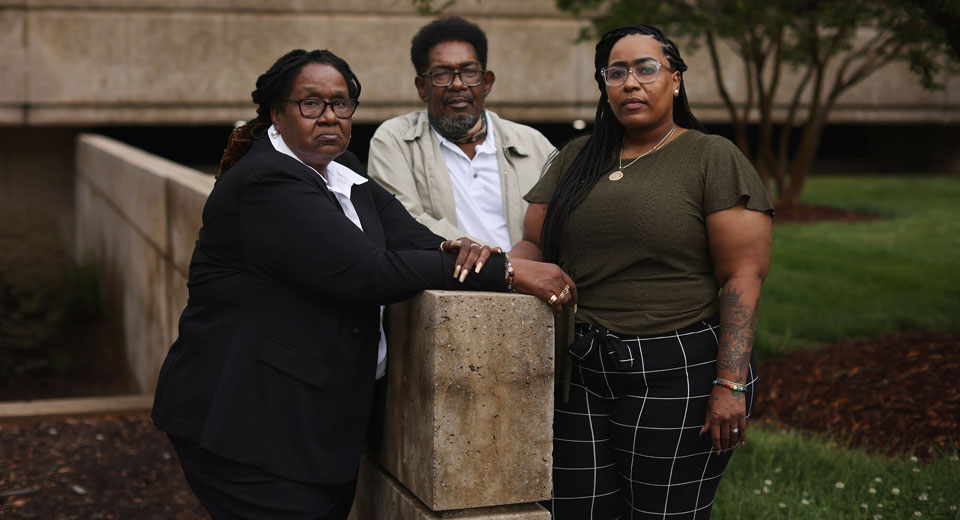
GREENSBORO, N.C.—On a warm October day in 2018, George and Mary Smith drove to police headquarters, where they had a 2 p.m. appointment to watch video of the death of their son Marcus.
Nearly everything they knew about the September 2018 incident in which he died came from a Greensboro Police Department press release, which said he had been suicidal and combative before collapsing as police tried to help him. A lawyer had secured their right to watch the body camera footage.
When they got to headquarters, Mary changed her mind.
“A mother doesn’t want to see her child fall off a bicycle, much less getting beat to death,” she said. “And that’s when I decided I did not want to watch.”
George watched the video and left headquarters convinced police had lied about his son’s death.
“It was terrifying, the only thing Marcus wanted was help,” he said. “I don’t know where they got the suicidal or combative or collapsing from. I didn’t see none of that.”
Like George Floyd under the knee of Minneapolis Police Officer Derek Chauvin, an autopsy found Smith was killed by positional asphyxia, though not by a knee on the neck, but by a controversial and widely banned practice called the “hogtie.”
The video showed that Marcus Smith was in distress and begging police to take him to the hospital or call an ambulance.
Officers pushed him face down on the street and tied a belt around his ankles and attached it to his cuffed hands so tightly his knees were lifted off the pavement. On the video, his last coherent words were “Help me.”
“That’s how my brother died,” said Kimberly Smith, his younger sister, who watched the video later. “He died like an animal.”
Hogtying is a troublesome word and a dangerous act. It involves putting a person on his stomach and tying his cuffed hands to his bound feet behind his back with an adjustable nylon belt, a device known as a “hobble.” Police officers have said the hogtie position is used to restrain individuals who can’t be restrained any other way and would otherwise pose a danger to themselves and those around them. The hobble device can be used to restrain someone’s legs without placing them in the compromised hogtie position.
The Department of Justice warned against hogtying as far back as 1995, in a bulletin instructing police how to prevent deaths in custody. The paper instructed officers to move the suspect off his stomach as soon as he was handcuffed, and included this directive: “Never tie the handcuffs to a leg or ankle restraint.”
Many police departments, including New York and Los Angeles, have banned hogtying for decades. But a joint investigation by NBC News and The Marshall Project found that a dangerous practice roundly rejected by experts has persisted in many places because of outdated guidelines and lax oversight. And the use of the hobble and hogtie may be even more widespread than can be determined because there are no national reporting requirements and many police departments don’t keep track.
Nationwide, NBC News and The Marshall Project identified at least 23 deaths involving hogtying or a hobble in law enforcement custody since 2010. From California to Maine, police have appeared to use a hobble to either tie a person’s hands and feet together behind them, put pressure on their back with bodyweight, or leave them prone for longer than recommended. Those cases include a chemical engineer in Mississippi who police said was acting strangely after taking LSD; an unarmed man running naked through his Alabama hometown; and a man who died on a Tacoma, Washington sidewalk after police deemed his actions suspicious. At least 13 people were mentally ill or in mental crises. Of those who died, 12 were White, nine were Black, and two were Hispanic.
Many departments do not track the use of the hobble device, or when it is used to hogtie, in their use-of-force data. But in those that do keep records, the hobble has been used hundreds of times in recent years.

Over the past five years, police in Aurora, Colorado, have used the hobble on roughly 350 people, nearly half of whom were Black. In Greensboro, court records show that in the four years before the death of Marcus Smith, Greensboro police used a hobble device to hogtie at least 275 people, two-thirds of whom were Black.
Tom Manger, former police chief in Montgomery County, Maryland, and former president of the Major Cities Chiefs Association says that in his 42 years as an officer he’s only seen the hobble used a handful of times.
“It should only be used when you have a situation where a person is violently combative [and] you have a lawful reason to take them into custody,” said Manger. “What you’re trying to do is make sure they don’t hurt themselves or hurt someone else.”
He himself has never used one.
“Cops need to be careful if they’re doing something like hobbling somebody,” said Manger. “They’d better be damn sure that they’re doing things right.”
The roughly 18,000 police departments in the U.S. have different policies, procedures, and training. Most of the nation’s largest police agencies tend to show awareness that the hogtie is dangerous, but not all ban it.
NBC News and The Marshall Project reviewed the policy manuals for departments in the 30 largest cities in the U.S.
Twenty-two have clear language prohibiting hogtying or attaching hands and feet behind a person’s back.
But in Charlotte, North Carolina; Columbus, Ohio; Houston, and Indianapolis, officers are allowed to restrain a person in this manner in certain circumstances or with certain provisions.
Charlotte Police Department policy advises officers to avoid hogtying but does not forbid it. Columbus police officers are told to make sure to provide slack in the rope that ties the hands and feet together. In Houston, only officers who are specifically trained in the technique can use it. Indianapolis warns officers to closely monitor people who have their legs and arms restrained behind the back.
In the Boston and Milwaukee manuals, there is no mention of hogtying or the hobble device. When questioned, both departments said they do not provide officers with a hobble.
The manuals in Nashville and Detroit have no language that directly addresses hobbles or hogtying.
There’s a reason for these discrepancies. In addition to the lack of national reporting requirements, many departments avoid using the word hogtie. They use phrases like maximal restraint, four-point restraint, hobble, RIPP Hobble, or Total Appendage Restraint Procedure (TARP).
To avoid injury, according to the DOJ’s 1995 bulletin, it’s essential to move the person on his side and off his stomach as quickly as possible.
But there is no federal standardized way to use the hobble and there are various points within the process where an error could be deadly. Departments have used different policies; some allowed the hands and feet to be tied together, while others instructed the cuffs to be attached to a belt around the waist. The tying of the hobble, the positioning of the person, and their subsequent transport can all contribute to injury or death.
Joelle DeVane owns the company that makes the original hobble device, the RIPP Hobble.
She said the hobble is a safe tool when correctly used by properly trained officers trying to restrain suspects who are kicking uncontrollably.
“The feet are a very powerful weapon and the legs are a very powerful weapon, especially if you have someone that is in an excited state,” DeVane said.
DeVane noted that the instructions that accompany the RIPP Hobble say “NEVER Hog-Tie a Prisoner.”

The hobble carries many risks, according to Keith Taylor, a 23-year veteran of the NYPD and now a professor at John Jay School of Criminal Justice. Officers know next to nothing about a person’s health, and there are serious outcomes when police immobilize an unhealthy person in a high-stress situation. Obesity, heart conditions, and drugs all can raise the chances of death.
Taylor says creating federal best practices that agencies must follow would improve police interactions with the communities they serve.
He said the only time police should use any type of maximal restraint is for people who are “not just belligerent, but dangerously resistant to being arrested.”
During Taylor’s entire career the NYPD trained officers not to hogtie.
“Personally, I would not use hogtying ever,” said Taylor. “That’s not something I would ever do. Not just because it’s banned, because it’s not safe.”
Hobble is not a word in common parlance, but it’s known in many police circles. Derek Chauvin asked for a hobble as he restrained George Floyd. The officers didn’t use one, however.
Vanessa Peoples had never heard the word before she was tied up with one.
Peoples said she was doing laundry in the basement of her Aurora, Colorado, home in 2017 while her two young children were upstairs. She didn’t hear Aurora Police officers banging on her door. A few days earlier, she said, her son had temporarily wandered away from a relative who was supposed to be watching him at a party in a park, so the police were there with a social worker to do a child welfare check.
Police entered the unlocked door. Body camera footage shows one officer entering the basement with her gun drawn.
When Peoples went upstairs, she said her living room was filled with law enforcement. On the video, an officer told her three times to stand back; each time Peoples said no.
The video shows that an officer grabbed Peoples by the neck and pushed her into the wall and then onto the floor face down. He straddled her legs and handcuffed her wrists behind her back. He tied her feet with a hobble and attached them to a belt around her waist. The whole time Peoples screamed for her mother and children. Seven times she told the officers she couldn’t breathe.
Body camera footage shows that they carried her out by her arms and shoulders and put her in a police vehicle and then on the front lawn. They eventually removed the restraints and took her to jail. An officer said in the police report that he heard a “pop” from Peoples’ shoulder and that she was taken to the hospital. Peoples says her arm was dislocated.
Peoples hired a lawyer, but before they filed suit the city settled the case for $100,000. Aurora Police say this does not admit fault. The city did not respond to a request for comment.
“When you feel that you’ve got to get a rope and just tie someone up like that, that’s not being treated as human,” said Peoples.
Four years later, Peoples still feels embarrassed that her neighbors saw her bound and screaming on her front lawn. She is wary of the police.
“The pain that I endured going through this, it’s unexplainable because I have to walk around every day with that on my mind.”
Two years later, and three days after the death of Elijah McClain at the hands of the same police department, Aurora Police were once again in the spotlight for misuse of the hobble on a Black woman.
Shataeah Kelly was arrested by Aurora Police in August 2019 on charges resulting from a fight. An officer decided to hobble Kelly after she tried to escape from his patrol car.
Police video shows that the officer placed Kelly in the backseat with her hands cuffed behind her back. Her bound ankles were pulled behind her back and attached with a hobble to a belt around her waist. She fell to the floor of the car. Kelly said she couldn’t breathe and asked to be moved but her pleas were ignored and she stayed, stuck on the floor, face down, for the 20-minute drive to the police station.
“I just didn’t know they could do that,” said Kelly. “I just feel like it was because I was Black and he was treating me like a slave.”
Then-Interim Chief of Police Vanessa Wilson, who is now chief, called the incident “egregious” and fired the officer.
“I was sick to my stomach. And then I turned to anger,” said Chief Wilson in an interview. “Because that’s not how we train and that’s not how we treat people. And it’s not how I expect my officers to behave.”
Kelly has retained counsel, the same lawyer who is representing Elijah McClain’s family in its ongoing suit against the city and city employees.
NBC News and The Marshall Project reviewed use-of-force data from the Aurora Police Department obtained via a state open records request and found the agency used the hobble on roughly 350 people over the past five years.
Police used the hobble on Black suspects slightly more frequently than on others. Thirty-nine percent of the suspects arrested by Aurora police in the past five years were Black, but Black people made up 43 percent of the people on whom Aurora police used force — and 46 percent of the people subjected to the hobble.
In 16 percent of the roughly 350 hobble incidents, the person was injured and required medical treatment.
As more scrutiny has been placed on Aurora’s use of the hobble in recent years, the directives in the department’s manual have changed and become more detailed.
In 2016, department policy advised police to avoid hogtying. In the most recent version, issued in late 2020 after the two incidents and one settlement, the policies clearly forbid hogtying. The department is replacing the hobble with a device that doesn’t allow legs to be bent backwards. “I think it’s also just sort of a more humane way of taking someone into custody if they are agitated,” said Wilson.
As a Greensboro music festival wound down in the early hours of Sept. 8, 2018, Marcus Smith approached a group of eight White police officers on traffic duty and ran frantically from officer to officer, begging for help.
Smith can be heard and seen on police body camera footage saying, “Please take me to jail.” “Call the ambulance bro!” “Take me to the hospital!” “Help me!” “Please sir, I’m going to kill myself.” “Lock me up please.”
After several minutes, police put him in the back seat of a cruiser. No one got in the driver’s seat. Smith, not yet handcuffed, became more agitated and rolled on his back. A body camera captured one officer worrying aloud that Smith might break his window.
“We should definitely RIPP Hobble him,” the officer said. “Is anyone willing to help?”
Greensboro policy allowed officers to tie a person’s hands and feet together when they needed a higher level of restraint than handcuffs, but the policy did not define when this higher level of restraint was necessary or appropriate. Training materials warned officers that “Arrestee face down and ‘hogtied’ (knee bend greater than 90°) in transit” was a dangerous position that could lead to positional asphyxia.
Police pulled Smith from the car and put him face down in the street. Smith protested, yelling, “No, you can’t do that, I ain’t resisting.” At least four officers held him down, cuffed him behind his back, strapped the hobble around his ankles, and attached it to the handcuffs. Body camera video showed it took officers two minutes and 40 seconds to hogtie him before they stood up as Smith lay face down and motionless.
“Are you still with us?” an officer asked Smith as soon as the hogtie was complete. He knelt down, put two fingers on Smith’s neck, and couldn’t find a pulse. Smith was declared dead an hour later after failed attempts to revive him.
Over the next few hours, Police Chief Wayne Scott watched body camera video before issuing a press release about officers trying to help: “While officers were attempting to transport him for mental evaluation, the subject became combative and collapsed.”
Smith’s friends and family were suspicious. Marcus was homeless and struggled with substance abuse, but they knew him as unfailingly polite and upbeat. Nine days after his death, an outreach worker for the homeless wrote Scott and the city council and asked “how such a beautiful life could come to such an abrupt end.” The letter requested the public release of body camera video and all pertinent information, and said, “Chief Scott, we need answers.”
The chief replied via email two days later that there was nothing to worry about. He wrote that after reviewing videos, autopsy reports, and other evidence, he concluded the officers “acted appropriately and with great compassion while trying to help a citizen in need.”
An internal investigation found no violation of policy and Scott returned all the officers to active duty.
After viewing the body camera video, however, the Smith family believed there was a cover-up that had begun with the chief’s first press release. Kimberly Smith called the release “a plain lie,” and insisted her unarmed brother posted no threat to eight armed officers. “Why didn’t they just handcuff him?”
On Nov. 30, 2018, the state medical examiner released the final autopsy results. The death was ruled a homicide, caused by “sudden cardiopulmonary arrest due to prone restraint.”
A few hours later, Scott issued a special order reversing department policy. Officers can no longer connect bound feet or ankles to handcuffs.
The Smith family filed a lawsuit in April 2019 alleging wrongful death and a cover-up. The mayor declined to comment for this story. Scott, who has since retired, did not respond to emails or a certified letter requesting comment. The Greensboro Police Department declined to answer any questions because of the ongoing lawsuit.
For two years, officials have fought the case vigorously and have denied wrongdoing or a cover-up in court filings and in depositions. They have argued that the restraint was appropriate in light of the safety risk Smith posed to himself or others.
Marcus’ mother, Mary Smith, said she does not believe police intended to kill her son. They were negligent, treated her son like a throwaway, she said and should be convicted of manslaughter.
“A lot of Black men would not walk up to eight White police officers at night and say, ‘I’m in trouble, I’m on drugs, I need help,’” she said.
“He was looking for help, and he went to the right people. And they killed him.”
This article appeared originally on The Marshall Project website.













Comments